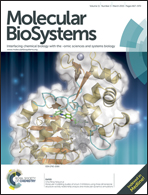A transcriptomic analysis for identifying the unintended effects of introducing a heterologous glyphosate-tolerant EPSP synthase into Escherichia coli†
Abstract
Glyphosate is one of the most commonly used broad-spectrum herbicides with little to no hazard to animals, human beings, or the environment. Some microbial 5-enolpyruvylshikimate-3-phosphate (EPSP) synthase variants are not inhibited by glyphosate, and they provide a powerful tool to engineer glyphosate-tolerant plants. However, the unintended effects of EPSP synthase expression patterns on microbes are not yet clear. Here, we use an Affymetrix GeneChip analysis to study how introduction of a heterologous glyphosate-tolerant EPSP synthase into a model microorganism Escherichia coli (E. coli) affects the global gene expression profile. The profile showed that 161 of 4071 genes were differentially expressed after the introduction of the synthase: 19 (0.47%) were up-regulated and 143 (3.49%) were down-regulated. The microarray results, in combination with BiOLOG substrate utilization and amino acid composition assays, suggested that heterologous EPSP synthase expression had very minor effects on E. coli. Although a small number of genes and metabolites were affected by EPSP synthase expression, no functional correlations were identified among the dataset. This study may shed light on the effect of EPSP synthase expression on microbes, which should help in the assessment of environmental safety.


 Please wait while we load your content...
Please wait while we load your content...